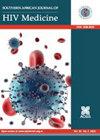Dolutegravir用于二线治疗:新证据的规划意义。
IF 2.3
4区 医学
Q4 INFECTIOUS DISEASES
Southern African Journal of Hiv Medicine
Pub Date : 2022-09-05
eCollection Date: 2022-01-01
DOI:10.4102/sajhivmed.v23i1.1428
引用次数: 1
摘要
本文章由计算机程序翻译,如有差异,请以英文原文为准。
Dolutegravir for second-line treatment: Programmatic implications of new evidence.
Copyright: © 2022. The Authors. Licensee: AOSIS. This work is licensed under the Creative Commons Attribution License. Dolutegravir, an integrase strand transfer inhibitor, with an optimised nucleoside reverse transcriptase inhibitor (NRTI) backbone is the World Health Organization (WHO)-recommended second-line antiretroviral therapy (ART) regimen for adults after failing a first-line regimen based on a non-nucleoside reverse transcriptase inhibitor (NNRTI), either nevirapine or efavirenz.1 This WHO recommendation is based on the DAWNING study, which showed that dolutegravir was superior in both safety and efficacy compared to lopinavir-ritonavir, when administered with two NRTIs, at least one of which had to be fully active on resistance testing.2 The World Health Organization recommends substituting tenofovir with zidovudine when switching to second-line ART to ensure that there will be at least one fully active NRTI because the signature tenofovir resistance mutation K65R does not compromise zidovudine’s effectiveness and there is limited access to resistance testing in high-burden, resource-limited settings to select an optimised NRTI backbone.3
求助全文
通过发布文献求助,成功后即可免费获取论文全文。
去求助
来源期刊
CiteScore
2.80
自引率
11.80%
发文量
41
审稿时长
>12 weeks
期刊介绍:
The Southern African Journal of HIV Medicine is focused on HIV/AIDS treatment, prevention and related topics relevant to clinical and public health practice. The purpose of the journal is to disseminate original research results and to support high-level learning related to HIV Medicine. It publishes original research articles, editorials, case reports/case series, reviews of state-of-the-art clinical practice, and correspondence.

 求助内容:
求助内容: 应助结果提醒方式:
应助结果提醒方式:


